
HOST- Matthew Scott Phillips
TYPE- Theory
DURATION- 15:17
BUMPER MUSIC- "Drums Only Forever / Forever Only
Drums" (Miguel Martinez)
ANNOUNCER- Mike Cunliffe
Part 2 of 2, in our theory fundamentals series, this episode will cover the elements of rhythm. Learn about note values and their durations. Explore time signatures and how to distinguish simple and compound meter.
RHYTHM- Very closely tied to pulse, a regular repeated pattern of sounds that move music forward.
NOTE- A symbol used to signify the duration and pitch of a tone.
DOTTED NOTE- Lasts for the duration of the note plus half the duration of the that note.
METER- Grouping of beats into equal parts, based on stressed and unstressed beats.
MEASURE- One repetition of a pattern of stressed and unstressed beats.
METER SIGNATURE- A number representing the grouping of beats that comprise the meter.
DUPLE METER- A meter with one stressed beat and one unstressed beat.
TRIPLE METER- A meter with one stressed beat and two unstressed beats.
SIMPLE METER- When the pulses can be divided into 2's.
COMPOUND METER- When the pulses can be divided into 3's.
WHOLE NOTE
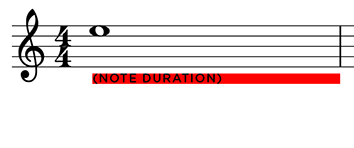
COUNT: 1 2 3 4
HALF NOTES (1/2)
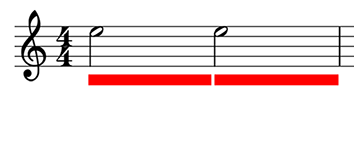
1 2 3 4
QUARTER NOTES (1/4)
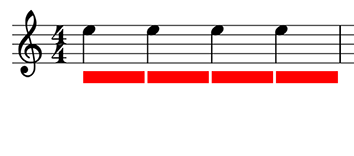
1 2 3 4
EIGHTH NOTES (1/8)
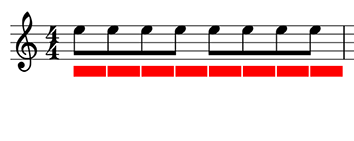
1 + 2 + 3 + 4 +
A QUICK NOTE ON RESTS
In the following example, "DOTTED QUARTER NOTES", there are two symbols that aren't notes. These are called RESTS. A rest is the absence of a note, or simply a silence that spans the time that a note would normally occupy.
REST NOTE
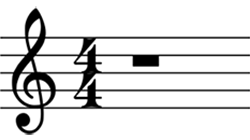
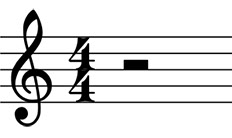

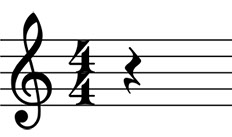

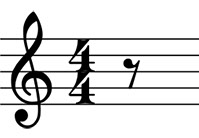

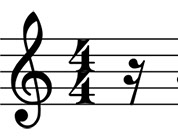

DOTTED QUARTER NOTE
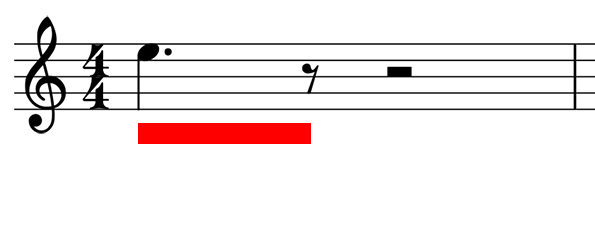
1 + 2 + 3 + 4 +
DOTTED HALF NOTE
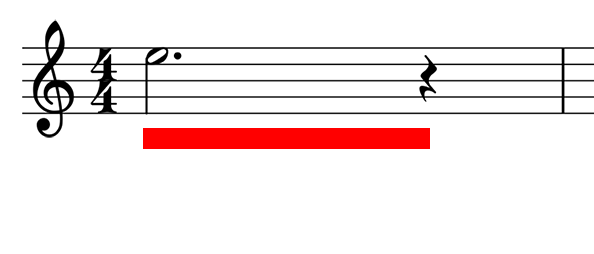
1 2 3 4
METER SIGNATURE (TIME SIGNATURE)
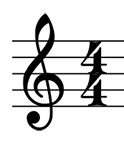
TOP NUMBER=Number of beats or pulses per measure.
BOTTOM NUMBER=What type of note gets the beat. Ex. 4=quarter note, 8=eighth note, etc.
Therefore, the above example represents
FOUR QUARTER NOTES per measure, also known as COMMON TIME.
A QUICK NOTE ON DRUM NOTATION
The following examples will feature DRUM NOTATION, which is UNPITCHED. This is indicated by the two bars to the left of the 2/4 meter signature. It's very similar to regular notation, in terms of note values, but the pitch positions actually represent different pieces of the drum kit rather than notes. Here's an example of the drum notation we will be using:
These two bars, where a clef symbol would normally be, > indicate an unpitched instrument.

< HI HAT
< SNARE
< KICK
SIMPLE METER
(BEATS, OR PULSES, CAN BE DIVIDED INTO 2's)
2/4 METER (CUT TIME)
1 stressed, 1 unstressed

1 2
KICK
(stressed)
SNARE
(unstressed)
3/4 METER
1 stressed, 2 unstressed
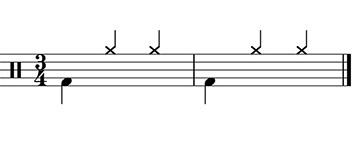
1 2 3
1 2 3
KICK
(stressed)
HI HAT
(unstressed)
4/4 METER (COMMON TIME)
1 stressed, 1 unstressed,
1 slightly stressed, 1 final unstressed
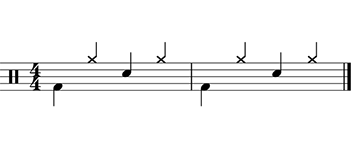
1 2 3 4
KICK
(stressed)
HI HAT
(unstressed)
SNARE
(slightly stressed)
1 2 3 4
8 EIGHTH NOTES
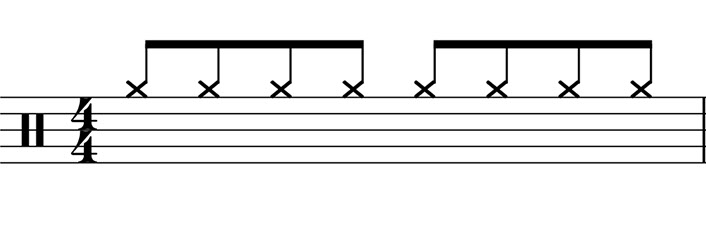
1 + 2 + 3 + 4 +
16 SIXTEENTH NOTES

1 e + a 2 e + a 3 e + a 4 e + a
COMPOUND METER
(BEATS, OR PULSES, CAN BE DIVIDED INTO 3's)
6/8 METER
1 stressed, 2 unstressed,
1 slightly stressed, 2 unstressed

1 2 3 4 5 6 1 2 3 4 5 6
UNEQUAL METER
(BEATS CAN BE DIVIDED INTO 3's AND 2's)
5/8 METER
1 stressed, 2 unstressed,
1 slightly stressed, 1 unstressed
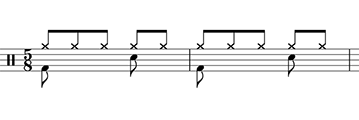
1 2 3 4 5
1 2 3 4 5
5/8 METER (different grouping)
1 stressed, 1 unstressed,
1 slightly stressed, 2 unstressed

1 2 3 4 5
1 2 3 4 5
TRIPLET (notes grouped in 3)

1 2 3 4 1 2 3 4
DUPLET (notes grouped in 2)

1 2 3 4 5 6 1 2 3 4 5 6
-Be able to distinguish the difference between a NOTE and a DOTTED NOTE.
-Each note duration has a complementary REST.
Try to memorize these and their counter parts.
-Familiarize yourself with UNPITCHED NOTATION or, as in this case, DRUM NOTATION. You may have to use it or be asked to analyze it in the near future.
-Familiarize yourself with all varieties of METER SIGNATURES or TIME SIGNATURES, including SIMPLE, COMPLEX and UNEQUAL METERS.
-Be able to distinguish a DUPLET from a TRIPLET.
